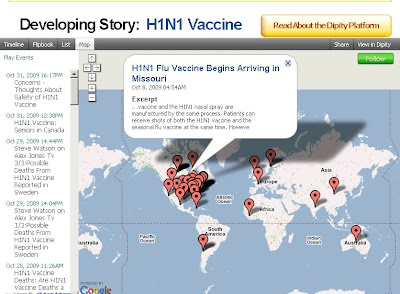When developing research projects, a timeline of events can be extremely helpful for illustrating the sequence and inter-connectivity of concepts. Dipity is an online resource which enables you to create interactive timelines and includes a timeline, flipbook, list and map view. On the main page the site includes a top news story theme and provides an interactive timeline of events. Below are some examples of the Timeline and Map functions in Dipity related to the H1N1 Vaccine.


The dipity website also enables you to create a login where you can add content from Flickr, and RSS feed, blogs, YouTube, Twitter, and several other sources dynamically. You can even create individual events and add them to the timeline. Once you have created your timeline, post the link to Twitter, Facebook, Myspace, or embed the timeline widget on your own website!
Have fun experimenting with this site and share your feedback with us below.
Special Thanks to Steven Park from the University of Connecticut Learning Resource Center for sharing this link with us.






